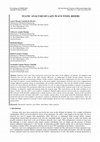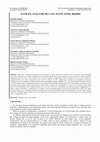Papers by Rosianita Balena

The main purpose of this technical paper is to analyze the various designs available for a Submar... more The main purpose of this technical paper is to analyze the various designs available for a Submarine Electro Hydraulic Umbilical, composed of power conductors, signal/control cables, steel tubes, thermoplastic hoses and/or optical cables, in order to reduce the options to the final project definition, considering the magnetic and thermal limitations of the components. The circulating current at the power cores may cause a heating, higher than the operational temperature limit of the others components (thermoplastic hoses) and an induced voltage at the signal cables. The thermal and electrical analyses are performed to ensure that the cable design comply with the specification and is suitable for its operation conditions. Finite element software for electromagnetic and thermal simulation is used and the analyses is based on the two dimensional geometry of the object under evaluation and its materials physical properties. The umbilical cable is suitable for static and dynamic applicat...

With the intention of automating parametric analyses of steel lazy-wave risers under different en... more With the intention of automating parametric analyses of steel lazy-wave risers under different environmental conditions a methodology was developed. This methodology builds different configurations of cables according to a pre-defined range of parameters as segment lengths and floaters data. Each configuration is then analyzed for a set of load cases. Five types of analyses are done, to say: Neutral, Static, Dynamic, Internal Stress and Fatigue. The methodology was implemented in order to verify which the best configurations are as quick as possible. Therefore, some simplifications in the models were done to make all the analyses feasible in the early stages of the riser design. The focus of this paper is the influence of the flotation in lazy-wave configurations of steel risers. In other words, considering given a set of environmental conditions, the parameters related to the floaters, such as diameter, length and pitch, and the position of the floating segment will be changed to verify their effects on results. The results of a real case are discussed, improving the knowledge about lazy-wave, since that configuration appears as a possible solution for ultra deepwater oil fields.

Catenary risers have been extensively used in the late years on the offshore oil industry. Its si... more Catenary risers have been extensively used in the late years on the offshore oil industry. Its simplicity and relatively low cost are some of the main reasons. However, as submerged oil fields become deeper, lazy-wave configurations become an interesting solution. Unlike catenary, finding the best configuration of a lazy-wave is not an easy task. It requires several simulations due to the great number of parameters involved. Lazy-wave configurations include different segments, being an intermediate one provided with floaters. Not only the lengths of these segments need to be chosen but also the floaters' characteristics as well. To help solving this problem a software of parametric analysis was developed. The parameters taken into account are the lengths of the segments and, in the case of presence of floater, its diameter, length and spacing along the segment span. This work focuses on the static problem in two stages. Firstly, only the cable's own weight is considered. Platform offset and sea current loads are considered after. The selection of the feasible configurations is made based on some criteria such as top angle, tension at the top and at the touchdown point, curvature and cable's wave heights, among others. A case study using this homemade software is performed and shows how helpful is parametric analysis in obtaining the feasible lazy-wave configurations. Also, the results are highly explored to provide a better understanding about lazy-wave configurations and to choose the best among them.

A lazy-wave configuration appears as an alternative to steel catenary free hanging risers in deep... more A lazy-wave configuration appears as an alternative to steel catenary free hanging risers in deepwater oil exploitation since this configuration can reduce loads and increase fatigue life. However, many design cycles must be done to obtain a feasible configuration for the riser. In each design cycle, several geometric configurations must be analyzed. If a lazy-wave solution is considered, there are many parameters to be varied to achieve the best configuration resulting on thousands of geometric configurations to be analyzed, considering both extreme and fatigue loading conditions. So a very great number of analyses must be carried on. Among those configurations many are not geometrically possible and others don't meet some design restrictions such as top angle limits, tension ranges and curvature radius values, reducing the total number of cases to be considered. This paper presents the methodology used in fatigue analyses of a lazy-wave steel riser, considering a pre-selected group of configurations. It aims to analyze and approve configurations according to some pre-defined fatigue criteria, such as fatigue life at TDP. The inputs for these analyses are configurations that are geometrically possible and approved by static and dynamic analyses under extreme loads. The simplified fatigue models that were developed are presented and a case study is performed focusing on its results and the "best" configuration choice.

Volume 3: Pipeline and Riser Technology; Ocean Space Utilization, 2008
This paper presents the tests performed for the qualification of the level of accumulated plastic... more This paper presents the tests performed for the qualification of the level of accumulated plastic strain (APS) to be respected by manufacturing and installation of SAF 2507 steel tube umbilicals. The manufacturing and installation processes for steel tube umbilicals are carried out through repetitive cycles of coiling and uncoiling the tubes or umbilical during manufacturing. During installation the umbilical is also coiled and uncoiled in installation reels or vessel’s baskets (turn tables or carrousels) as well as straightened and bent under tension over sheaves or chutes. These operations impose tensile and compressive strains to tube, which means that the tube is submitted to work hardening and have its mechanical properties modified to a certain extent during its manufacturing and installation processes. Therefore, it becomes necessary to quantify the level of APS expected to occur during these processes and compare it to the maximum level of APS qualified for the tube material being used in order to ensure that the mechanical properties of the steel tube are maintained at a high quality level. The scope of this paper is to present the tensile and fatigue tests performed by Marine Production Systems do Brasil (Brazilian Oceaneering Factory) in strained and unstrained tubes and define a maximum acceptable level of APS. Both strain hardening and fatigue life influence effects are assessed. Based on the results of these tests, the maximum acceptable level of APS to be respected during the manufacturing and installation of umbilicals was defined and associated with this level, the S-N curve determined by the tests must be used for the umbilical service life fatigue analysis.Copyright © 2008 by ASME
24th International Conference on Offshore Mechanics and Arctic Engineering: Volume 1, Parts A and B, 2005
Lazy-wave steel risers appear as a possible solution for ultra deepwater oil fields in Campos Bas... more Lazy-wave steel risers appear as a possible solution for ultra deepwater oil fields in Campos Basin. The design of such a solution, however, is a very time consuming task as several configurations must be studied, including static, dynamic and fatigue analysis. In the first cycle of design, simplified models can be used to speed up the selection process of feasible configurations. This paper presents a parametric analysis that was implemented on a computer tool, aiming to select the feasible geometric configurations for a lazy-wave steel riser in the first cycle of design.© 2005 ASME
Volume 3: Pipeline and Riser Technology, 2012
Vibração induzida pela emissão de vórtices-VIV. Riser rígido vertical. Variação de tração. Fadiga.










Uploads
Papers by Rosianita Balena